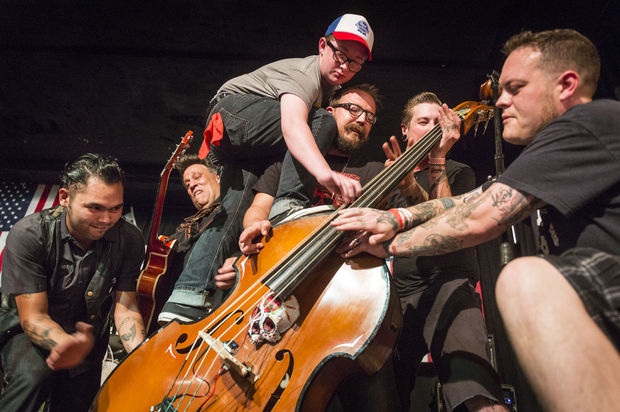I was just
looking at an Epi-uppy on eBay yesterday! The damn thing has been brutalized, probably the result of a gang-slapping.

I went back and looked again, and there's the heel crack we all know and love, and evidence of at least one neck reset. (Break out the Elmer's and carriage-bolts!)
At that price, he's not going to get that kind of money for it unless it's at gunpoint. And it's too bad because like you said, it's a venerable slapper and recording bass.
As for your Pappy's Kay, I found
this site with detailed info on Kay uprights. (Engelhardt, King, White and American Standard basses are also documented on that site, to some degree.) Kay basses are surprisingly rare, when you look at some of those production numbers. Note that blondes are the most valuable. As usual.
Kay was the first company to produce an internally-amplified upright bass, using a microphone mounted on the inside end of the peg. (
You can hear the great James Jamerson use one in his German upright on Heat Wave, My Guy and Dancing In The Streets, as signified by a U in that list.)
The company that made the peg/mic was named AMplified PEG, later shortened to Ampeg.
Jamerson bought one of Ampeg's first amps, a B-15,
which was recently rediscovered and authenticated on PBS' History Detectives. I'll take '#%?? nobody but bassists care about' for $200, Alex.
With any luck, your pappy's Kay is a Maestro model, as played by The legendary Bill Black on all those great Sun recordings (in fact, it was Bill Black's combo, until a young singer named Elvis Presley joined.)
Bill also played with The Maddox Brothers and Rose, the Burnette Brothers, Jerry Lee Lewis (Great Balls of Fire!) the Everley Brothers and he was even a regular on Ozzy and Harriet until his tragic death from a brain tumor in 1965, at only 39 years of age. Bill was a real showman, too, climbing on top of his bass, twirling it and clowning around in general.
His Kay Maestro bass is now owned by Paul McCartney. I truly wish I was there with you when you're doing CSI on that baby, checking details, measuring, comparing. It's one of my favorite things to do.
If you ever have to fill or plane string wear out of a fingerboard again, you might want to try an old violin repair technique if you have to take the neck off: cut tiny strips (with a wedge-shaped profile) from the back of the fingerboard where it hangs out in space - and nobody will ever see without an inspection mirror - and inlay them into the grooves. Alternately, you can grind a little off the underside of the fingerboard and mix the resulting dust with epoxy and spackle it on the grooves.
Dan Erlewine's razor blade trick comes in handy for stuff like that. This guy has a cool idea for a truss rod (kinda, since it only affects about half the neck). Great idea to keep in mind, though. Y'all's Summers back east play hob on wood, y'know.
We haven't discussed amplification, which is a whole different beast with uprights. I've done a lot of experimenting with transducers, mics and preamps over the years. I'd love to compare notes.
For recording, I've got a matched set of AKG C-1000 mics I like to XY at an area of the top corresponding to the end of the fingerboard, for a real punchy sound with minimal string noise. (The mics are actually aimed under the string and neck to isolate a square foot or so of real estate. I find that anywhere on the bottom bout tends to be too boomy.)
For arco, I use an AKG 414 aimed just inside the bass f-hole from about six inches away (the tiniest adjustments allow more or less air from the f-hole.) through Sony MDR7506 headphones you can hear just astonishing differences with the slightest differences in angle. That's where the God's own bass tone lives, but it doesn't work as well with pizzicato, in my astoundingly humble opinion.
For slapping, I really love the Fishman BP-100, because the ceramic-piezo transducers are attached by clips between the strings.
They're the only system I know of that allows you to compensate for different string's sensitivity and volume - (though it's a bitch and a half to set up initially). Just a hair (you know what kind ) can spell the difference between people straining forward to hear or the whole front row being blown backwards out of their chairs, ears bleeding from the concussion blasts.
Once you've got the placement right, everything sorta moves topside, if y'knowm sayin'. You're getting the exact tone of the strings themselves, rather than the sound of the bridge or bass body, as occurs with transducers mounted between the bridge and body, on or in the adjustment wheel or inserted into the bridge scroll doohickey.
I've found that aside from the B-band (astronomically expensive) ribbon transducer element, there doesn't seem to be that much difference in the sound of bridge mounted piezos. (Remember Barcus Berry hot dots?) the real difference is in the preamps. (He says. On Alembic's forum. To the collective duh from all the F2B Owners.)
Believe it or not, that little Shadow pickup/preamp referenced in my earlier tome is just killer for straight-up straight-to-amp drummer killer kinda thing. I know! That little thing? Yup.
David Gage Realist:
Fishman Full Circle:
Anyway, I'd love to hear your input about this stuff. Besides, if your pappy is anything like mine, simple is better. You can't trust mine with a remote of any kind because he'll just punch buttons on it at random, expecting it to do what he thinks it should do by human/digital osmosis or something. (Why is it always midnight on my VCR? was written with him in mind.)